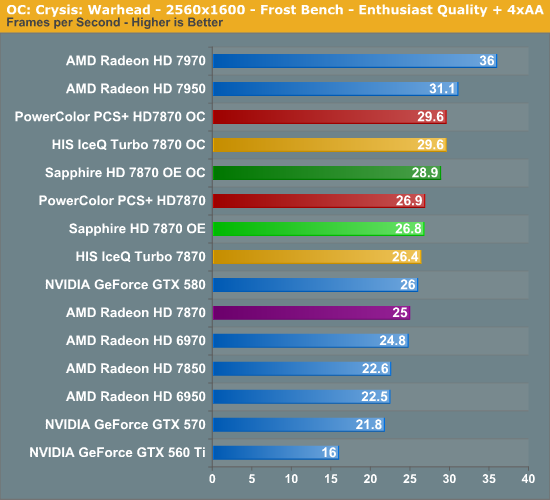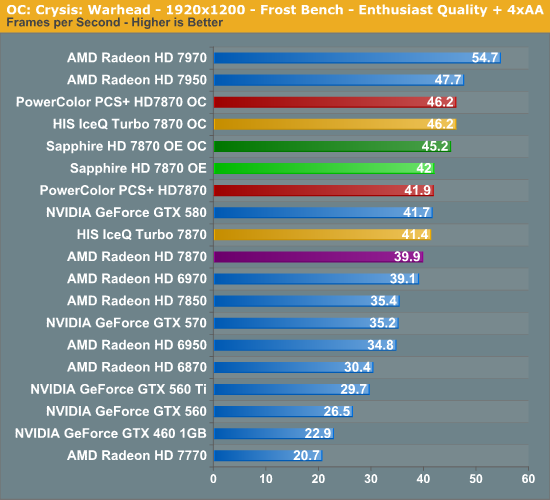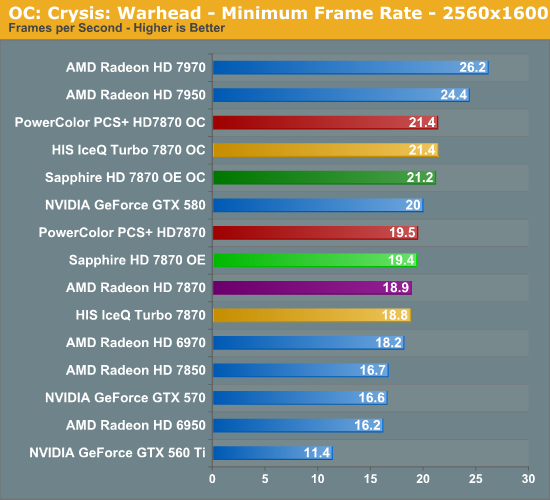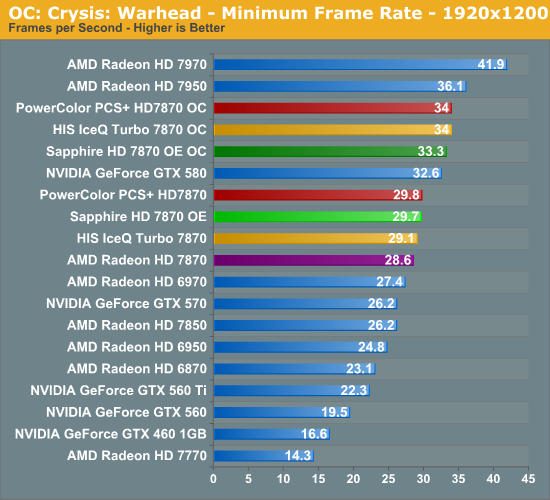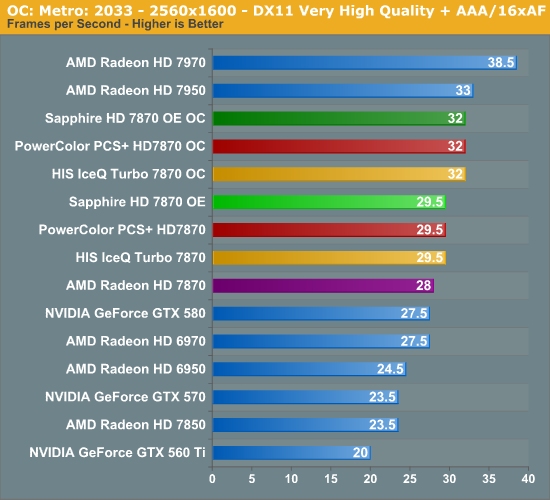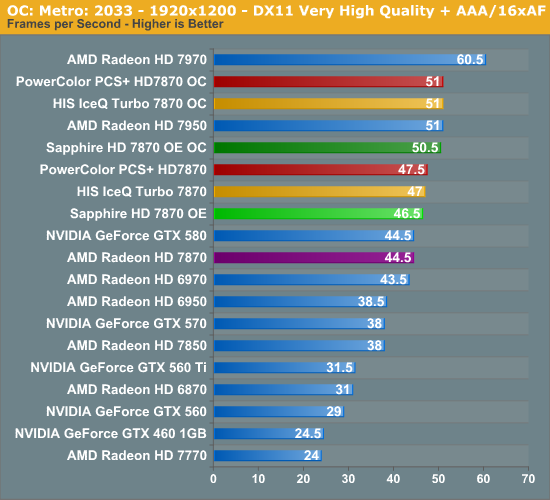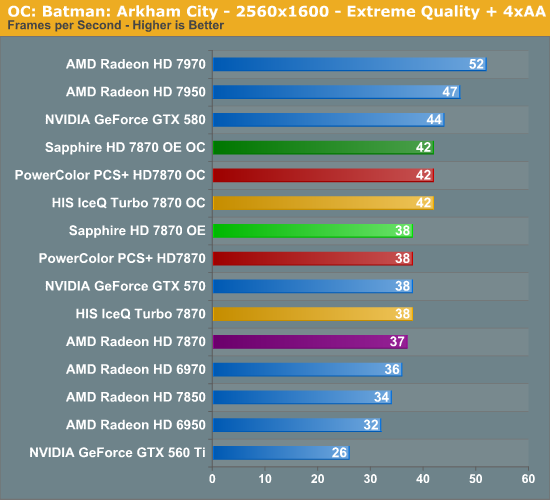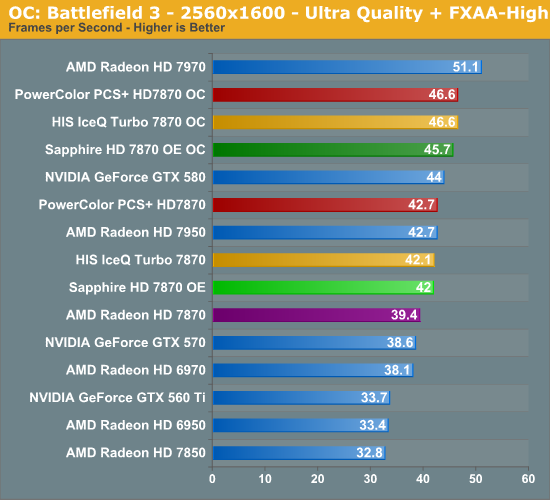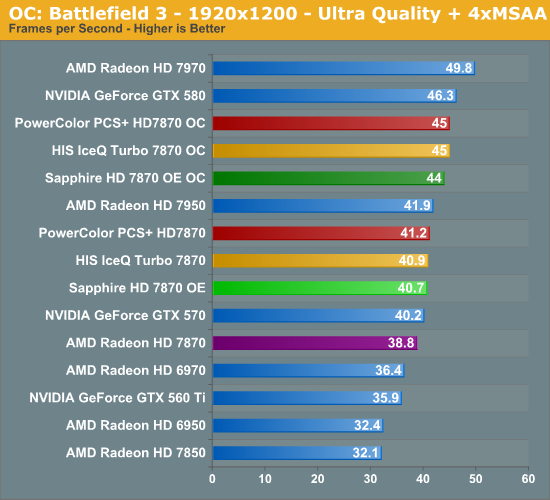
Original Link: https://www.anandtech.com/show/5767/capsule-review-sapphires-radeon-hd-7870-overclock-edition
Capsule Review: Sapphire's Radeon HD 7870 Overclock Edition
by Ryan Smith on April 28, 2012 4:45 PM EST- Posted in
- AMD
- Sapphire
- Radeon HD 7000
- GPUs
As AMD’s 28nm allocation has improved so has the selection of cards available on the market. We’re still in the first phase of the Radeon HD 7000 series rollout, with AMD’s partners building semi-custom cards based on AMD’s reference PCB, but even without custom PCBs AMD’s partners have been able to turn out a number of interesting designs. This is particularly the case for the 7800 series, where prices are high enough for partners to experiment with different coolers and TDPs are low enough to allow more than a handful of approaches.
Last month we saw some of those first designs with PowerColor’s PCS+ HD7870 and HIS’s IceQ 7870 Turbo, and today we’ll be looking at a third: Sapphire’s HD 7870 Overclock Edition, their semi-custom factory overclocked 7870. How does Sapphire’s dual-fan entry stand up to the competition? Let’s find out.
| Radeon HD 7870 Partner Card Specification Comparison | ||||||
| Sapphire HD 7870 Overclock Edition | PowerColor PCS+ HD7870 | HIS IceQ Turbo 7870 | AMD Radeon HD 7870 (Ref) | |||
| Stream Processors | 1280 | 1280 | 1280 | 1280 | ||
| Texture Units | 80 | 80 | 80 | 80 | ||
| ROPs | 32 | 32 | 32 | 32 | ||
| Core Clock | 1050MHz | 1100MHz | 1100MHz | 1000MHz | ||
| Memory Clock | 5GHz GDDR5 | 4.9GHz GDDR5 | 4.8GHz GDDR5 | 4.8GHz GDDR5 | ||
| Memory Bus Width | 256-bit | 256-bit | 256-bit | 256-bit | ||
| Frame Buffer | 2GB | 2GB | 2GB | 2GB | ||
| PowerTune Limit | 190W | 190W | 190W | 190W | ||
| Manufacturing Process | TSMC 28nm | TSMC 28nm | TSMC 28nm | TSMC 28nm | ||
| Width | Double Slot | Double Slot | Triple Slot | Double Slot | ||
| Length | 10" | 9.5" | 11.25" | 9.5" | ||
| Warranty | 2 Years | 2 Years | 2 Years | N/A | ||
| Price Point | $359 | $369 | $389 | $349 | ||
Like the other 7870 cards we have reviewed so far, Sapphire’s HD 7870 Overclock Edition is a semi-custom card, meaning Sapphire is using an AMD reference board equipped with their own cooler. On top of the cooler Sapphire adds one further degree of customization here, as this is an Overclock Edition card, meaning it ships with a factory overclock. Sapphire is shipping the card with a modest boost to both core and memory clocks, shipping at 1050MHz core and 5GHz memory, representing a 50MHz (5%) core overclock and a 200MHz (4%) overclock over the stock 7870. This isn’t as aggressive as what we’ve seen PowerColor and HIS do, but then the price premium isn’t nearly at high either.
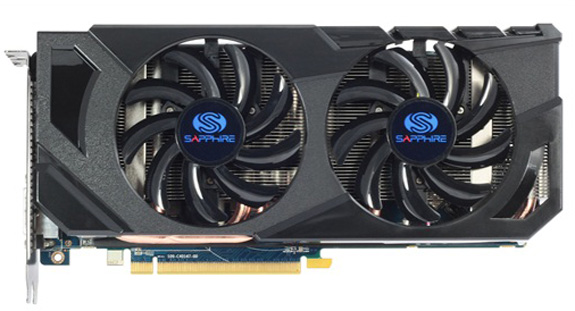
Breaking down the card, Sapphire’s cooler of choice is a slightly smaller version of their Dual-X cooler. The Dual-X is your typical double-wide dual-fan open air cooler, with 2 fans providing copious airflow over an aluminum heatsink running virtually the entire length of the card. As with the larger Dual-X cooler we saw on their 7950, the Dual-X on the 7870 is slightly oversized, allowing for slightly larger fans. In exchange the Dual-X on the 7870 is about 10mm taller than the PCB, and 0.5” longer than the 7870 PCB, pushing the card out to 10” long.
Meanwhile contact with the GPU is provided through an aluminum baseplate. Embedded in the baseplate are the card’s 4 copper heatpipes, which in turn run to various locations on the heatsink. Elsewhere Sapphire uses a small aluminum plate covering part of the PCB to function as a heatsink for the GDDR5 RAM.
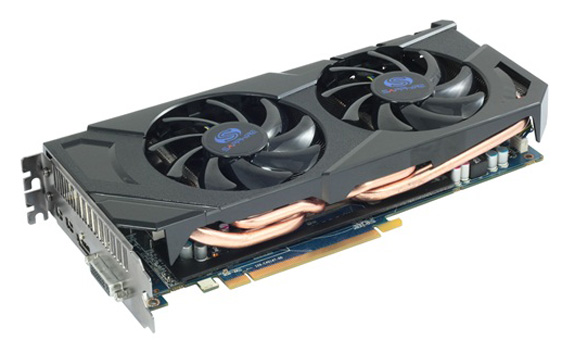
Unfortunately while Sapphire has built a good cooler for the 7870, they’ve done a subpar job on overall build quality. The cooler itself is fine, but like most other dual-fan coolers it’s only secured to the PCB around the GPU, meaning additional support for the PCB is required. In place of a full shroud providing stability there should be a stiffener running along the card, and while Sapphire’s aluminum plate provides some support it’s not nearly long enough. As a result roughly a third of the card – the tail-end portion of the card farthest from the GPU – doesn’t have any kind of support, leaving the PCB free to flex. This oversight isn’t likely to result in damage so this isn’t a dealbreaker, but at this point we’ve come to expect better, especially for cards in this price range. It goes without saying that handling the tail-end of the PCB should be avoided.
Wrapping up our look at the design of the card, as this is an AMD reference PCB the rest of the card uses the same 7870 design we’ve seen before. At the tail-end of the card are 2 6-pin PCIe power sockets, which are a bit harder to reach thanks to the oversized cooler, but not altogether difficult. Meanwhile at the front Sapphire is using AMD’s standard port configuration for display connectivity: 2 miniDPs, 1 HDMI port, and 1 DL-DVI port. Unlike some of the other 7870 cards we’ve seen, Sapphire is not using the optional second DVI port, so a full size vent is present.
Rounding out the package is the usual collection of dongles and materials. Sapphire includes 2 molex-to-6pin PCIe adaptors, an HDMI to DVI dongle, a miniDP to DisplayPort dongle, a DVI to VGA dongle, a CrossFire bridge, and a 1.8m HDMI cable. Along with the dongles Sapphire packs a quick start guide and a driver installation CD. As the driver CD itself is rather barebones Sapphire doesn’t include a copy of their TriXX overclocking utility, but at this point it wouldn’t do you any good anyhow – Sapphire has yet to update TriXX to support the 7800 series, so it can’t properly read the card. For overclocking you’ll need to use Overdrive or other 3rd party overclocking utilities.
Finally, let’s talk about pricing and warranties. Sapphire is selling the HD 7870 OE for $359, only $10 over AMD’s $349 Radeon HD 7870 MSRP. As Sapphire uses the same Dual-X cooler on their stock-clocked 7870 the $10 premium is entirely for the factory overclock, and while a similar 5% overclock should be easily attainable on virtually all 7870 cards, as far as factory overclock pricing is concerned $10 for 5% more is a reasonable deal here. As for the warranty, the HD 7870 OE ships with Sapphire’s standard 2 year warranty.
Performance
So how does the HD 7870 perform? Since the biggest differentiating factor among AMD’s partners right now is their choice of coolers, let’s start there.
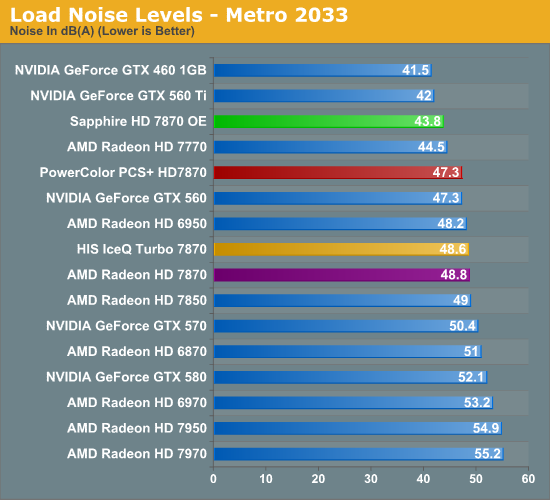

As we’ve come to expect from the Dual-X and other open air coolers, Sapphire’s cooler does very well here. Under Metro it’s by far the quietest 7870 we’ve tested, coming in at only 43.8dB, which makes it quieter than even the reference 7770 and only a few dB over our noise floor. Sapphire doesn’t make any temperature tradeoffs here either, hitting a quite cool 66C, 2C cooler than the reference 7870 and its fully enclosed blower design. With that said, the use of an open air cooler is a tradeoff in and of itself, and like other open air cards Sapphire’s 7870 needs a case with good airflow to breathe since it ends up recycling hot air.
The HD 7870 OE’s gaming performance on the other hand is not particularly exceptional for 7870 cards. The performance of the 7870 scales well with clockspeed so gaming performance benefits from Sapphire’s 5% core overclock in most situations, but looking at the big picture 5% isn’t a huge difference. In the case of Battlefield 3 it’s enough to nudge performance over 60fps, but it isn’t going to significantly change your playable settings. Ultimately there’s not a lot Sapphire can do here, as the 7870 being the higher tier 7800 series card means that it’s already running closer to the limit of the Pitcairn GPU.
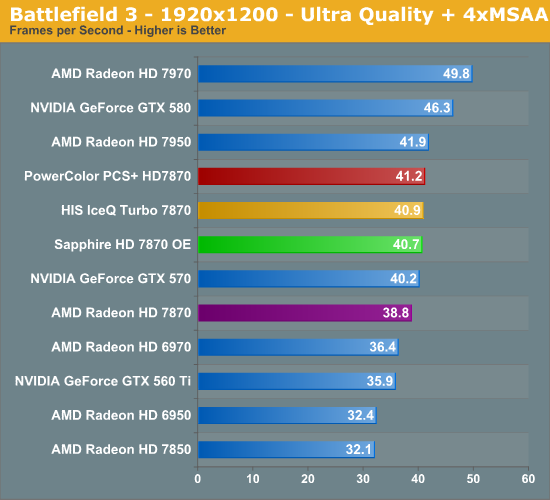
Overclocking can push the card a bit farther of course. In this case we hit 1150MHz core and 5.4GHz memory, which is a bit lower than what we’ve hit with other 7870s but since all of these cards are using the same PCB it’s purely the luck of the draw.
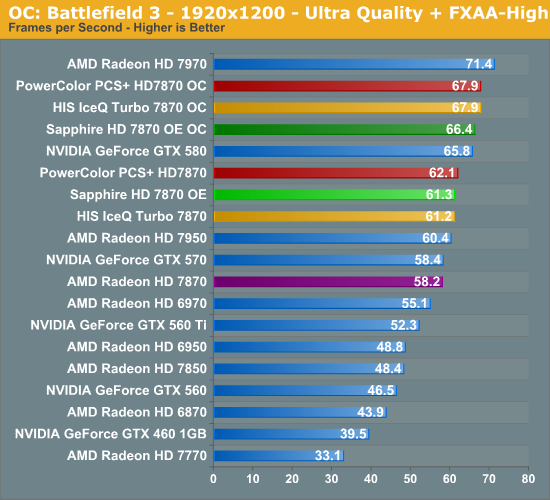
Final Words
At this point we’ve looked at several different Radeon HD 7870 designs, open air and closed blowers, extreme performance and balanced designs alike. To that end Sapphire’s HD 7870 OE fits in well with the balanced group, offering a decent factory overclock alongside a conventional but effective cooler. The subpar build quality of the card keeps it from being a true superstar, but otherwise Sapphire has done a good job here of balancing every aspect of the HD 7870 OE to make the card a solid performer.
The end result of Sapphire’s efforts is that of all the 7870 cards we’ve looked at the HD 7870 OE is easily the quietest and it doesn’t make any temperature compromises to get there. Hardcore overclockers will likely want a bit more, but for more traditional gamers with cases that can handle open air coolers this is the semi-custom 7870 to get – the HD 7870 OE offers all of the performance of a 7870 and more, and it does so with as little noise as possible. From a noise/performance perspective the 7870 is the current sweet spot, and Sapphire’s HD 7870 OE is sitting right in the middle of it.
Crysis, Metro, DiRT 3, Shogun 2, & Batman
| CPU: | Intel Core i7-3960X @ 4.3GHz |
| Motherboard: | EVGA X79 SLI |
| Chipset Drivers: | Intel 9.2.3.1022 |
| Power Supply: | Antec True Power Quattro 1200 |
| Hard Disk: | Samsung 470 (256GB) |
| Memory: | G.Skill Ripjaws DDR3-1867 4 x 4GB (8-10-9-26) |
| Case: | Thermaltake Spedo Advance |
| Video Cards: |
AMD Radeon HD 7970 AMD Radeon HD 7950 AMD Radeon HD 7870 AMD Radeon HD 7850 AMD Radeon HD 7770 AMD Radeon HD 6970 AMD Radeon HD 6950 AMD Radeon HD 6870 NVIDIA GeForce GTX 580 NVIDIA GeForce GTX 570 NVIDIA GeForce GTX 560 Ti NVIDIA GeForce GTX 560 NVIDIA GeForce GTX 460 1GB |
| Video Drivers: |
NVIDIA ForceWare 295.73 AMD Catalyst 12.3 |
| OS: | Windows 7 Ultimate 64-bit |
As the HD 7870 OE ships with a fairly mild overclock, it effectively splits the difference between the reference 7870 and the other 7870s we've seen with larger core overclocks. That said all of these cards are fairly close, offering varying degrees of overclocks at similarly varying prices with no single card doing particularly better than the others in that respect.
AMD's recent 7900 series price drop means that the 7950 is now within $50 of the reference 7870 and onyl $40 of the HD 7870 OE, but at the same time these overclocks close what was already a small gap. While the remaining gap depends on the game, with a 250MHz advantage the HD 7870 OE makes a very good case for grabbing what's otherwise a smaller, less power hungry card over AMD's lower-tier 7900.
In any case, since all of these 7870 cards are so close we'll skip the running commentary here on game performance.
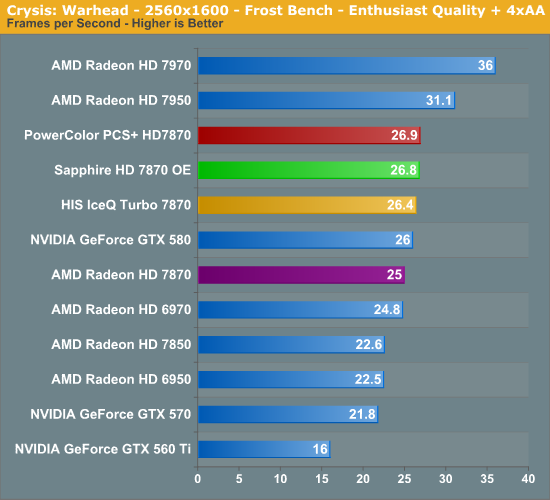
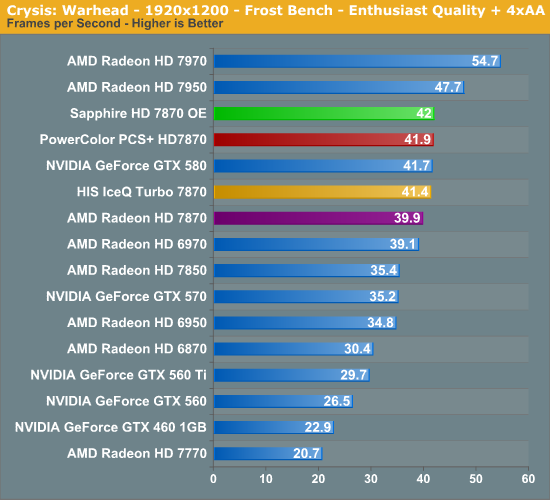
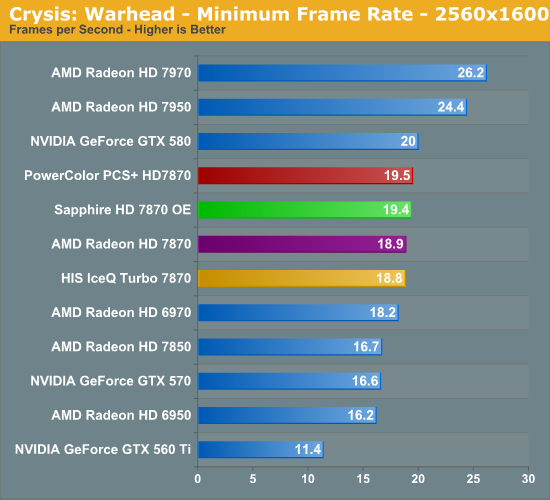
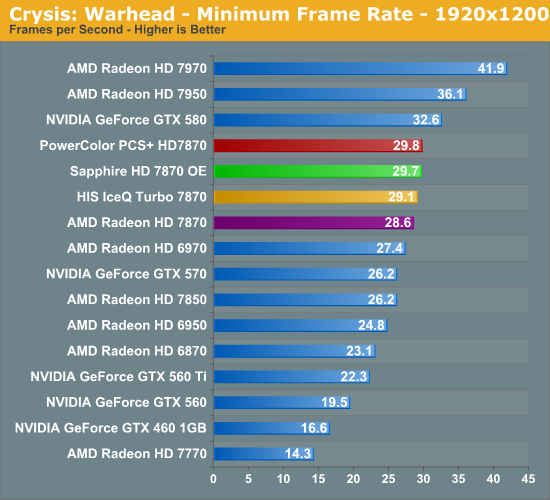
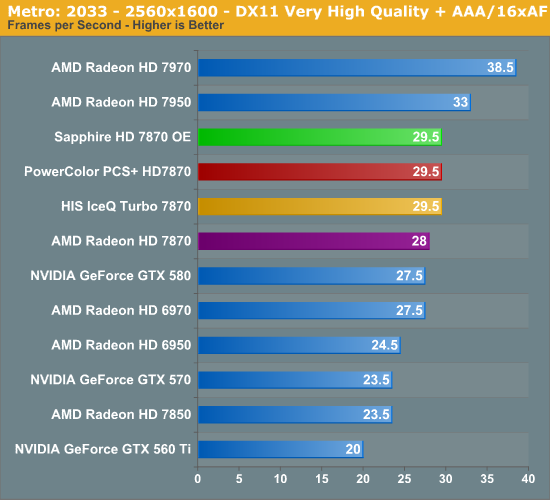
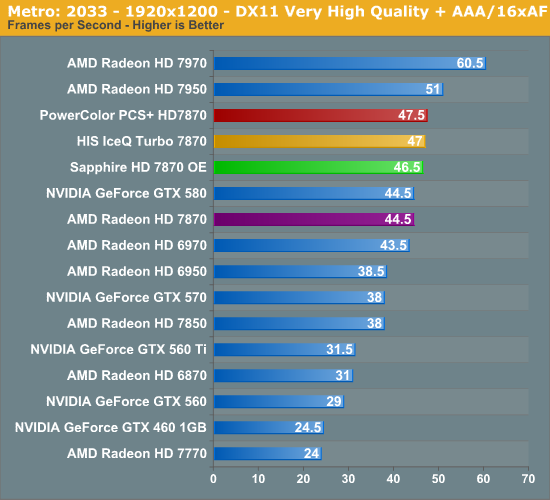
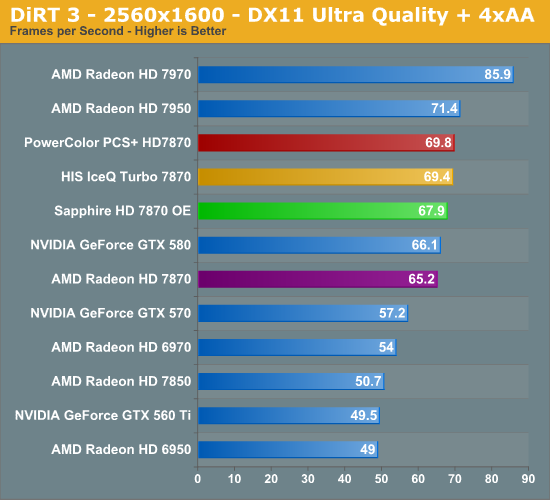
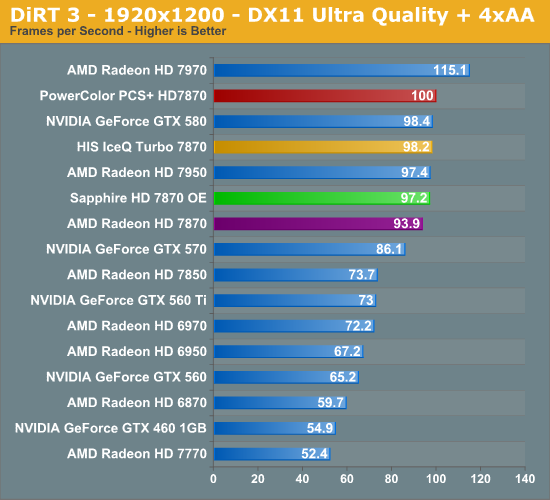
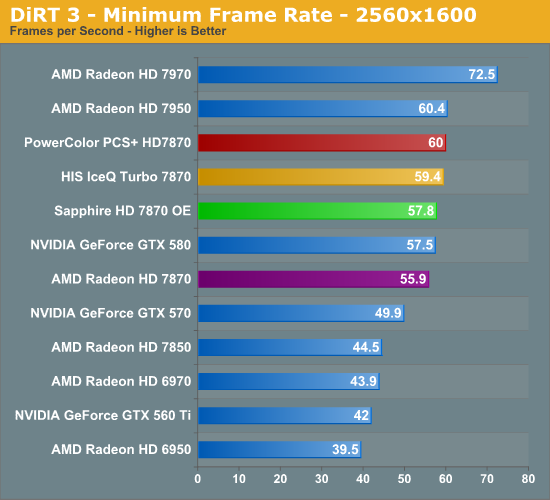
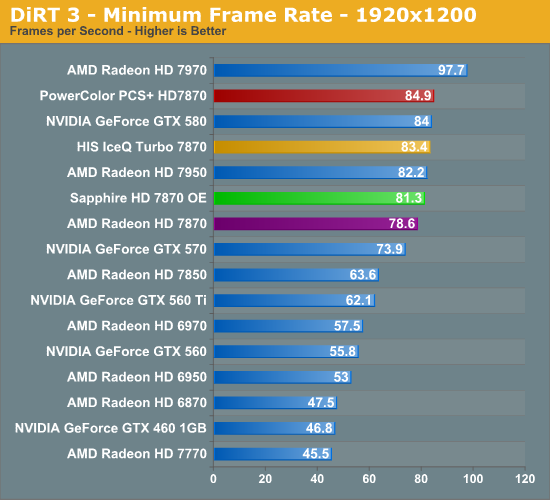
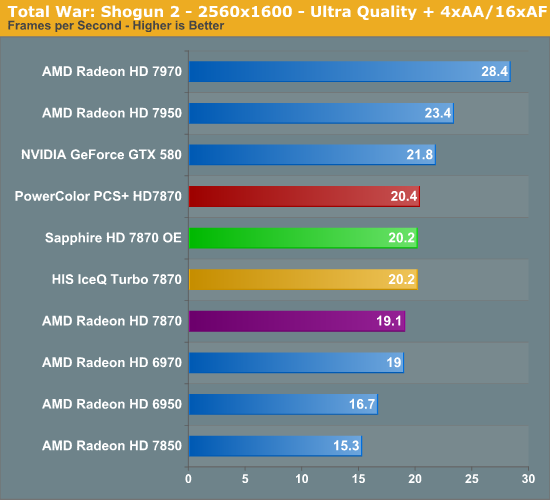
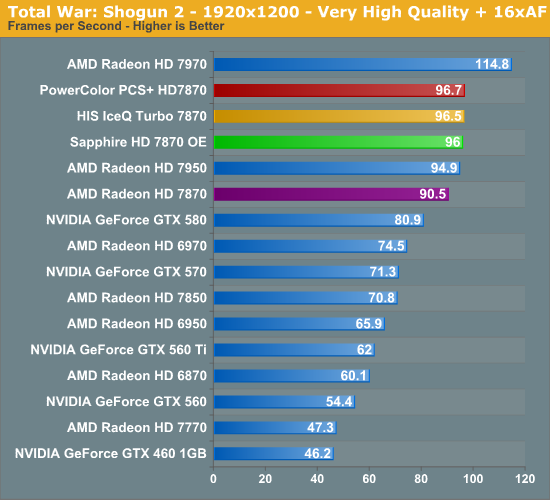

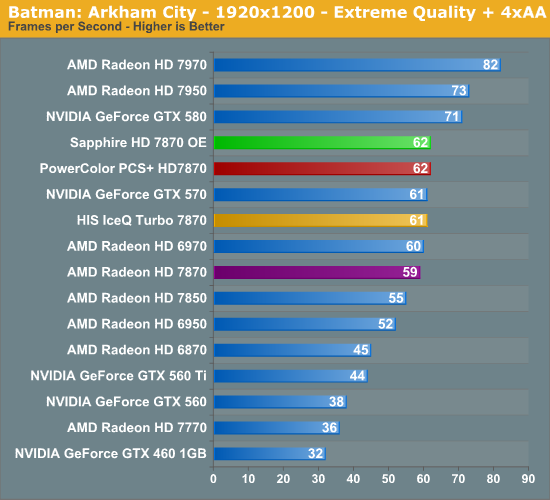
Portal 2, Battlefield 3, Starcraft II, Skyrim, CivV, & Compute
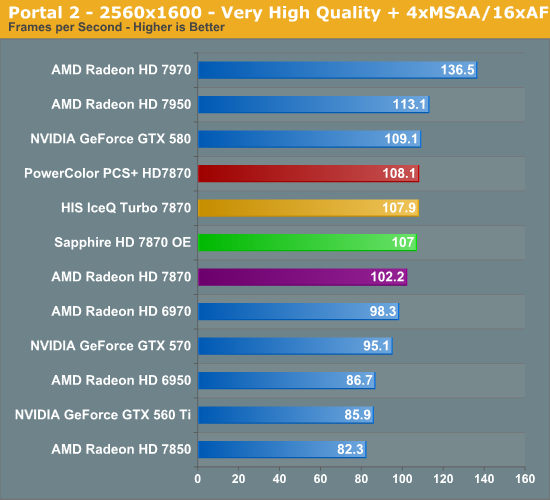

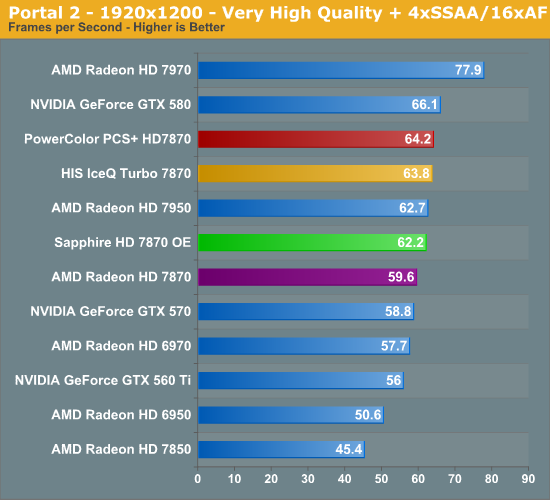
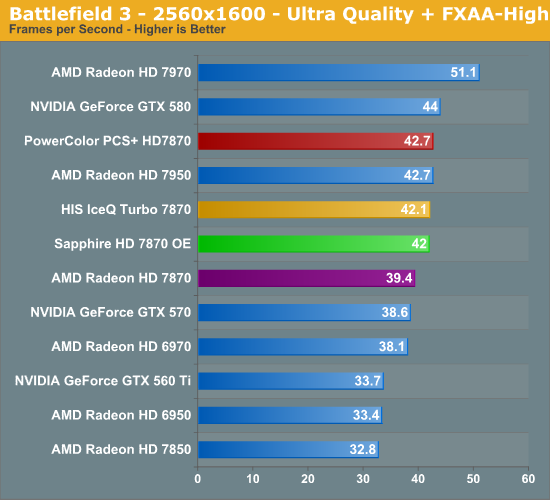

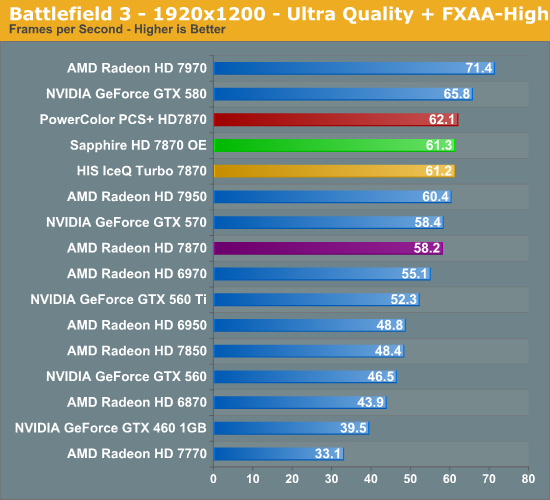
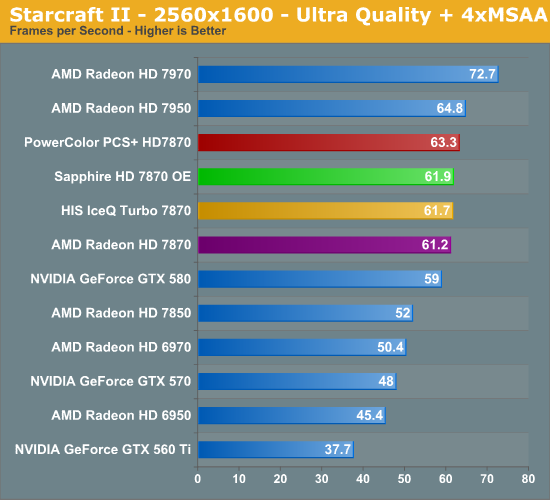

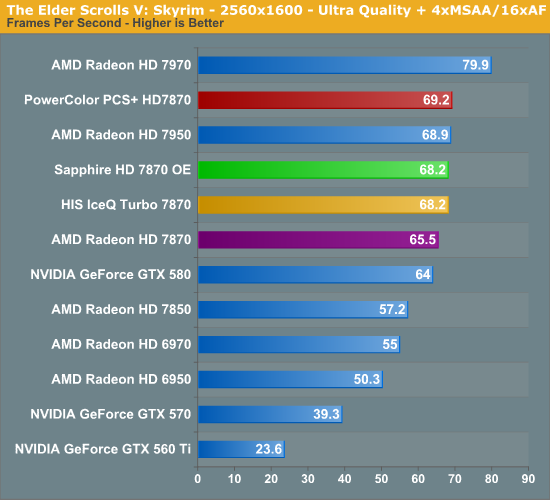
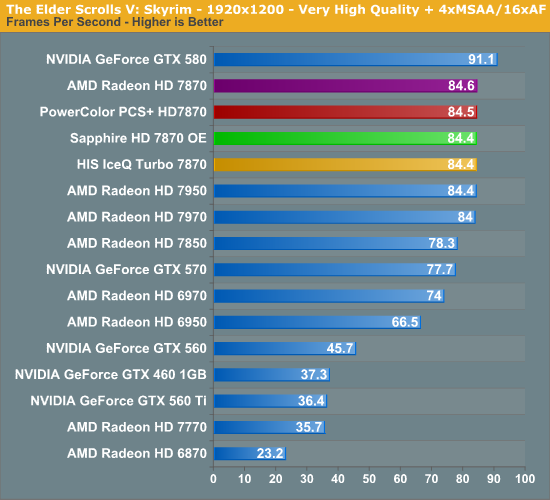
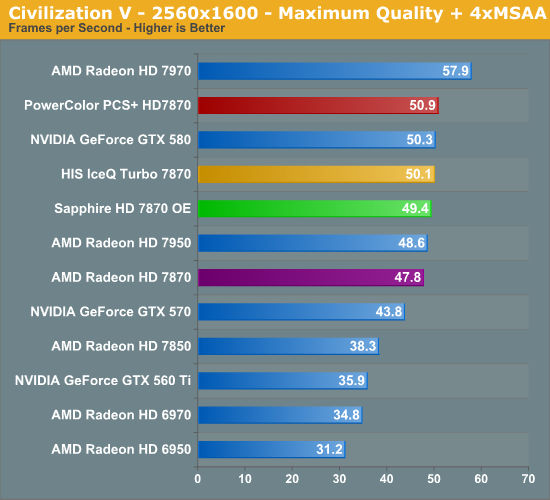
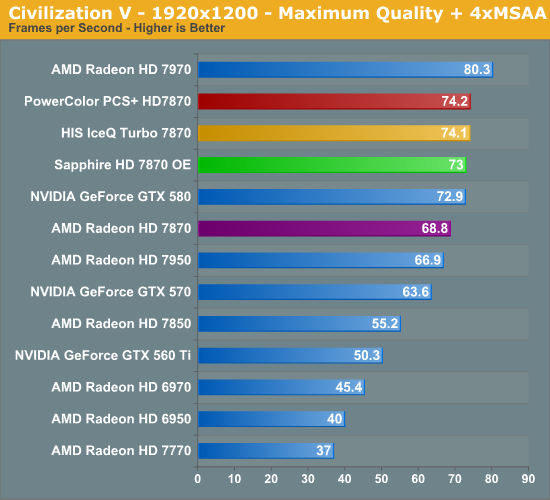
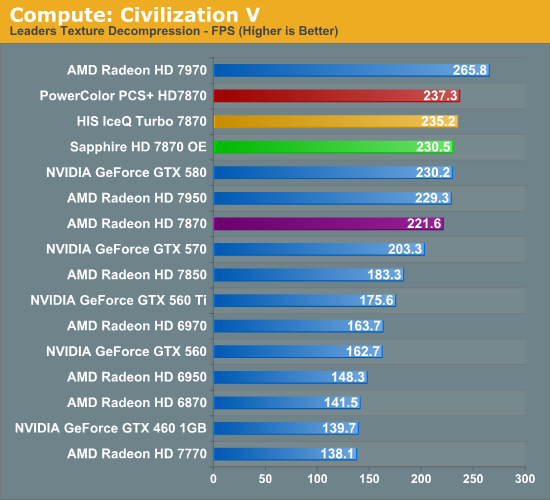
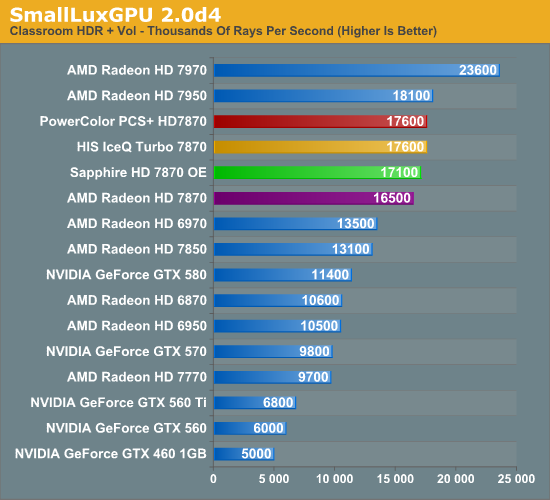
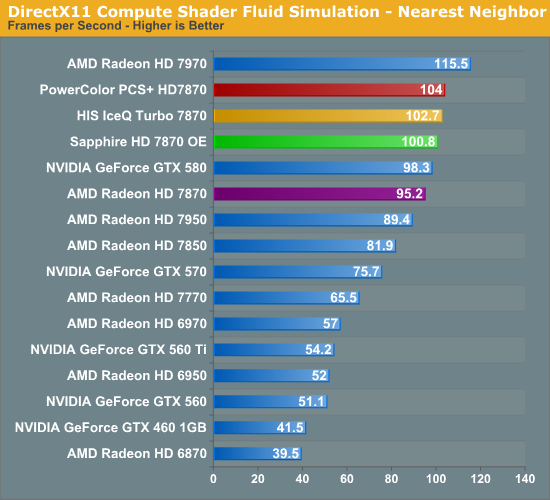
Power, Temperature, & Noise
Up next, we wrap up our look at a new video card’s stock performance with a look at the physical performance attributes: power consumption, temperatures, and noise. As we quicked look at in our capsule review, the HD 7870 OE manages to hit a good balance between all 3 of these attributes, leading to it being by far the quietest 7870 without making any compromises on temperature. Now let's further break down that data.
| Radeon HD 7870 Voltages | |||||
| Ref 7870 Load | Sapphire HD 7870 OE Load | HIS IceQ Turbo 7870 Load | PowerColor PCS+ HD7870 Load | ||
| 1.219v | 1.219v | 1.219v | 1.219v | ||
Note that unlike the 7900 series, we haven't seen any of the semi-custom 7800 series cards ship at a non-reference voltage so far, which means all of these cards generate a similar level of heat and consume a similar level of power.
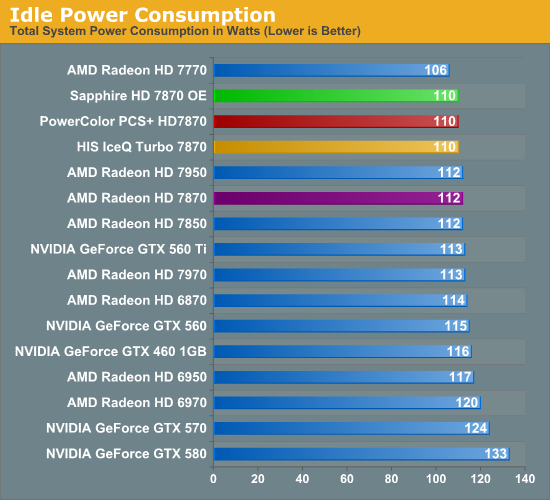
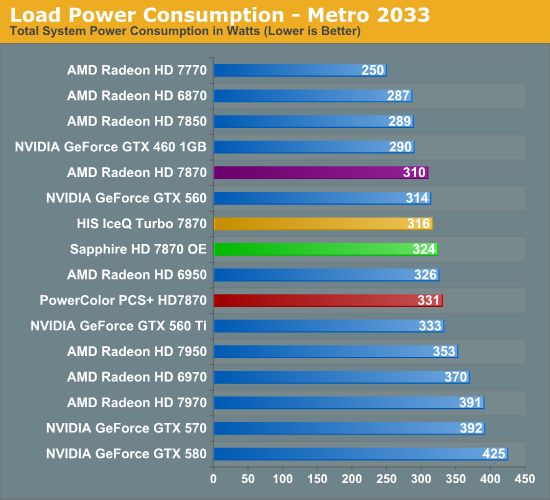
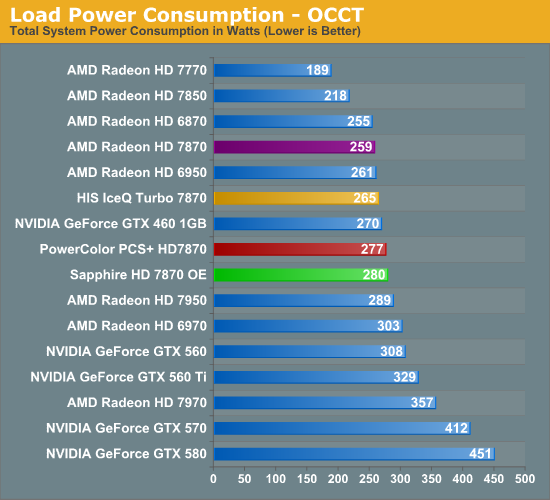
Idle power is consistent with our other 7870s, as we'd expect. Load power is much the same story, as the milder 50MHz core overclock on the HD 7870 OE brings up power consumption some compared to a reference 7870, but not by quite as much a more heavily overclocked 7870.
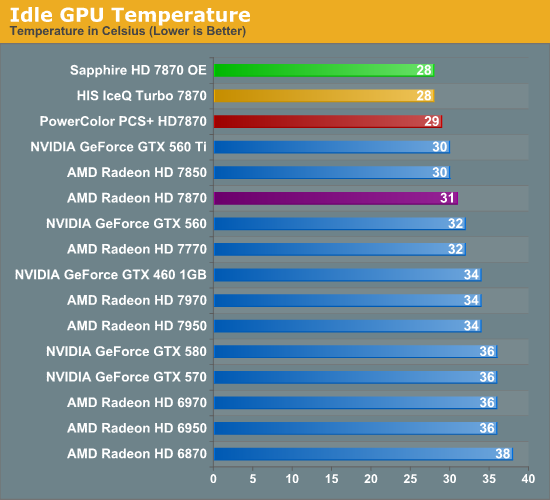


The version of the Dual-X cooler on the HD 7870 OE proves itself to be quite capable here. At 28C the idle temperature is among the lowest of any cards we have tested, but load temperatures are also quite good. 66C under Metro means that the Dual-X is 2C cooler than the reference 7870, and even OCCT can only push temps up to 70C. This does end up being louader than HIS's IceQ Turbo, but the IceQ was anything but conventional.
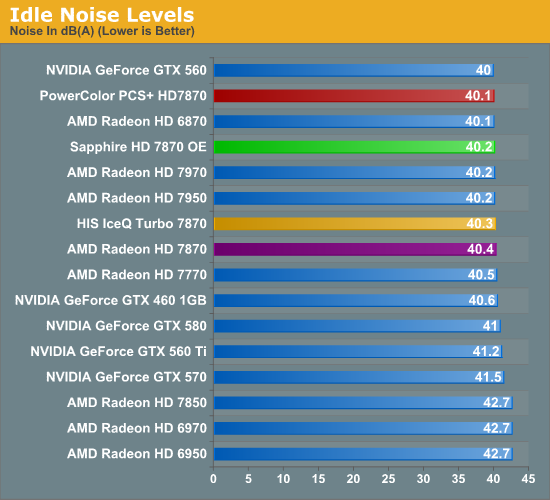

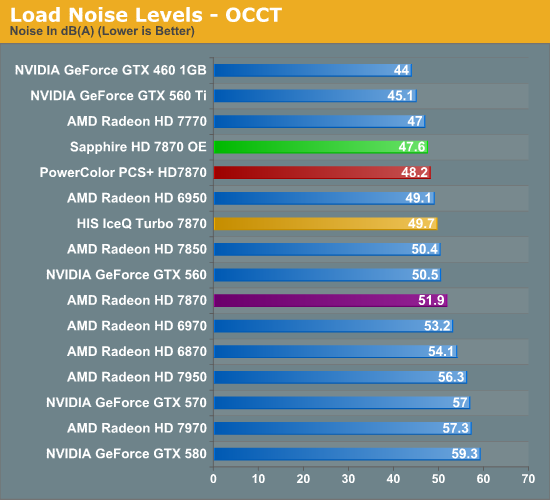
Finally we have our look at noise, which is without a doubt the biggest payoff for the HD 7870 OE. The load noise level during our Metro 2033 benchmark was only 43.8dB; this is not only over 3dB better than any other 7870, but it's also quieter than the otherwise much lower power (and lower performing) reference 7770. When it comes to enthusiast level cards we typically only see NVIDIA reference designs hit noise levels this low, so it's a notable accomplishment. Though for whatever reason - possibly an agressive fan curve - Sapphire's noise lead diminishes somewhat under OCCT; it's still the quietest 7870, but only by less than 1dB and it's no longer quieter than the 7770.
As always we wrap up our review of a customized card with a look at overclocking performance. Since the HD 7870 OE is a semi-custom card - meaning it's using AMD's reference board - there aren't a lot of surprises here. With competent cooling overclocking comes down to the luck of the draw; Sapphire's basic binning process for their OE cards should push the better boards into the OE product line, but even then there's no real guarantee how much higher any of these boards can go.
When it comes to overclocking our HD 7870 SE topped out at 1150MHz for the core clock and 5.4GHz memory clock. This is a 100MHz (9%) core overclock and 400MHz (8%) memory overclock respectively. As with other 7870 boards a 5.4GHz memory clock is a rather constant factor since all of these reference boards start seeing diminishing returns on performance at higher memory clocks due to memory bus errors, while the core overclock is 50MHz lower than we've seen on other 7870s, but as we said before this comes down to the luck of the draw.
| Radeon HD 7800 Series Overclocking | ||||||
| AMD Radeon HD 7870 | Sapphire HD 7870 OE | HIS IceQ Turbo 7870 | PowerColor PCS+ HD7870 | |||
| Shipping Core Clock | 1000MHz | 1050MHz | 1100MHz | 1100MHz | ||
| Shipping Memory Clock | 4.8GHz | 5GHz | 4.8GHz | 4.9GHz | ||
| Shipping Voltage | 1.219v | 1.219v | 1.219v | 1.219v | ||
| Overclock Core Clock | 1150MHz | 1150MHz | 1200MHz | 1200MHz | ||
| Overclock Memory Clock | 5.4GHz | 5.4GHz | 5.4GHz | 5.4GHz | ||
| Overclock Voltage | 1.219v | 1.219v | 1.219v | 1.213v | ||
So how well does the HD 7870 OE hold up once further overclocked?
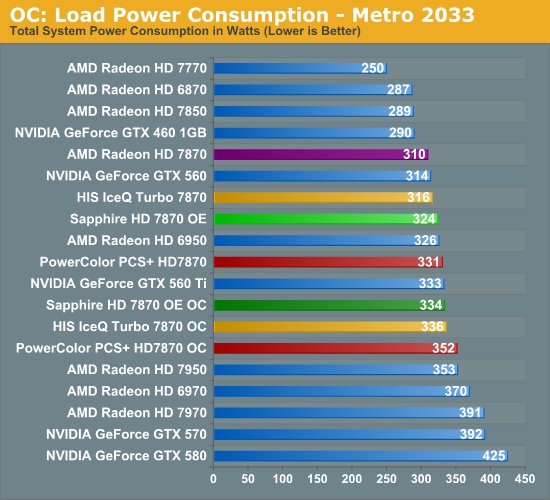
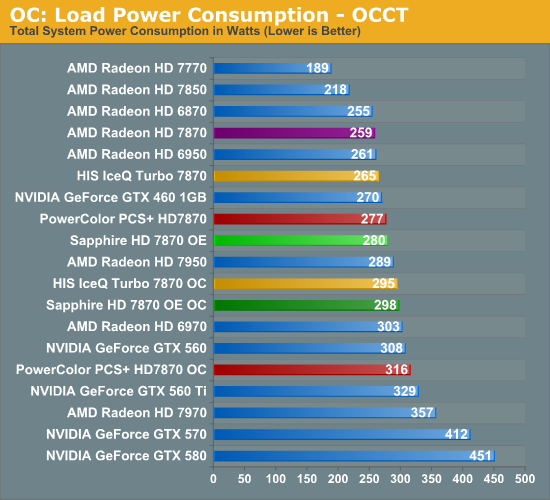
Our overclock pushed up power consumption by 10W under Metro and 18W under OCCT. Without any overvolting capabilities power consumption is largely kept in check, though we're still drawing nearly 40W more at the wall compared to a reference 7870.
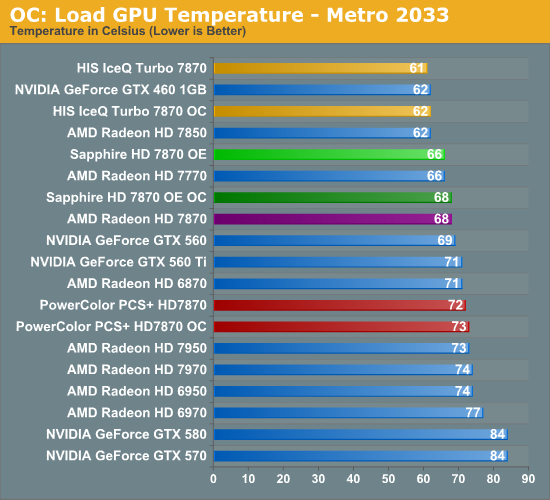
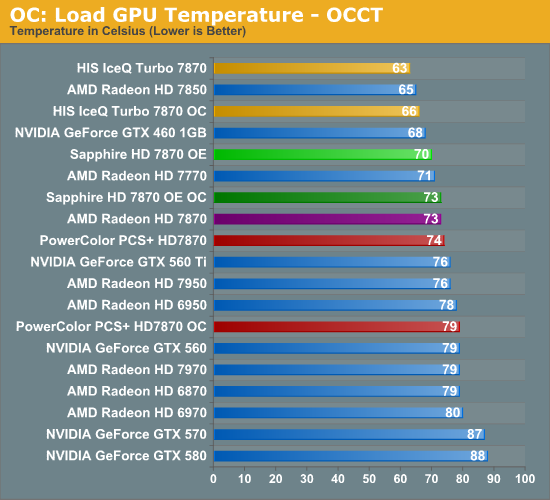
The slight increase in power consumption (and thereby heat generated) does little to faze the HD 7870 OE much here. Temperatures rise between 2-3C; even under OCCT the card is still relatively cool at 73C.
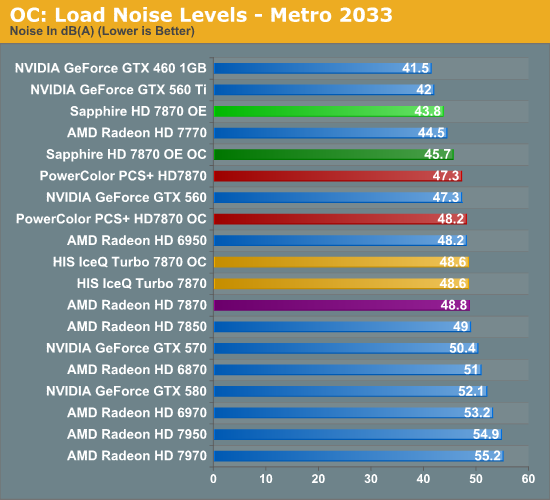
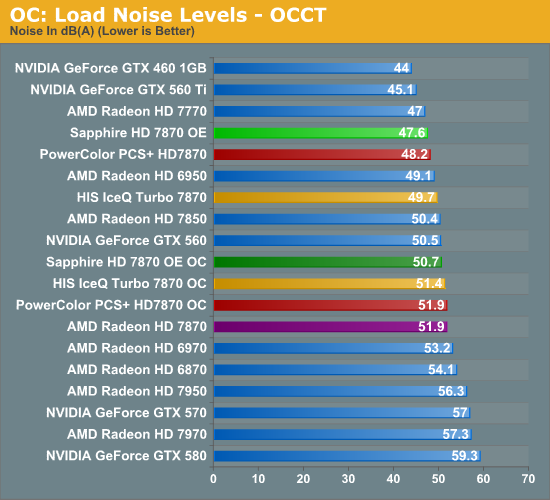
The tradeoff for holding those temperatures however is that the HD 7870 OE does give up some of its noise advantage. At 45.7dB under Metro it still easily maintains its reputation as the quietest 7870, but its lead has diminished and by the time you move into OCCT it's not significantly quieter than any other overclocked 7870.
Finally, how does performance look? We'll skip the running commentary on performance, but overall overclocking the HD 7870 OE has the expected performance improvements. In games where the 7870 was already close to the 7950 to begin with overclocking can push performance ahead of stock 7950 performance, which makes the HD 7870 OE's low noise all the more impressive. The fact that we only hit 1150MHz on our sample does mean that it slightly trails the other retail 7870s we've reviewed, however.
